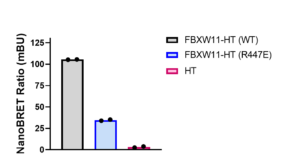Background
The SCF (SKP1-CUL1-F-box protein) E3 ubiquitin ligase is a complex of proteins that helps facilitate the ubiquitination of substrates for targeted proteasomal degradation. FBXW11 is F-box containing protein that has 11 WD-repeats and is a substrate recognition component of the SCF complex. FBXW11 recognizes and binds its substrates, including beta-catenin, at phosphorylated sites or phosphodegrons, and recruits it to the SCF complex for subsequent ubiquitination and degradation (PMID: 10321728)
Assay validation
Assay measuring the interaction of FBXW11 with B-catenin was developed using NanoBRET technology – a proximity-based assay that can detect protein interactions by measuring energy transfer from a bioluminescent protein donor (NanoLuc luciferase, NL) to a fluorescent protein acceptor (fluorescent ligand bound to HaloTag, HT). In the beginning, we determined the optimal tag orientation of donor constructs: N or C-terminally NL-tagged β-catenin and acceptor constructs: N or C-terminally HT-tagged FBXW11 in HEK293T cells. NL and HT proteins, expressed alone, were used as controls to determine background signal. The best results were obtained with C-terminally NL-tagged B-catenin and C-terminally HT-tagged FBXW11 (Fig.1). The assay was further validated with binding deficient FBXW11 mutant (R447E) designed by Matthieu Schapira. R447E mutation resulted in a significant decrease in the interaction of FBXW11 with B-catenin (Fig.2).

Fig.1. FBXW11 interaction with B-catenin – NanoBRET assay. HEK293T cells were co-transfected with C- or N-terminally NanoLuc (NL)-tagged B-catenin or NL alone and C- or N-terminally Halo-tagged (HT) FBXW11 or HT alone for 24 h. The interaction was measured using NanoBRET assay. The results are MEAN of 2 technical replicates.

Fig.2. R447E mutation decreases the interaction of FBXW11 with B-catenin. HEK293T cells were co-transfected with C-terminally Halo-tagged (HT) FBXW11 or HT and C-terminally NanoLuc (NL)-tagged B-catenin for 24 h. The interaction was measured using NanoBRET assay. The results are MEAN of 2 technical replicates.
Please go to Zenodo for experimental details.
Acknowledgments:
Matthieu Schapira – mutant design, Aidan Levinsky – help with mutagenesis
